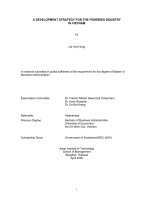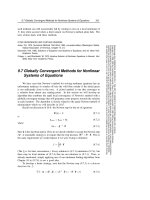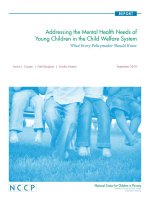Tài liệu Measuring the Socio‐economic Status of Higher Education Students ppt
Bạn đang xem bản rút gọn của tài liệu. Xem và tải ngay bản đầy đủ của tài liệu tại đây (410.12 KB, 21 trang )
MeasuringtheSocio‐economic
StatusofHigherEducationStudents
DiscussionPaper
December2009
TABLEOFCONTENTS
1. ExecutiveSummary ii
2. Background 1
3. Characteristicsofagoodmeasure 2
4. DimensionsofSocio‐economicStatus 2
4.1 Education 3
4.2 Occupation 4
4.3 Economicresources 4
4.4 Community 5
5. Currentdevelopments 6
6. DataSources 6
6.1 Current 6
6.2 Potential 7
7. Considerationsfordata 8
7.1 Validityandreliability 8
7.2 SensitivityandPrivacyofdata 9
7.3 Timing 10
7.4 Cost 11
8. Implementation 11
8.1 Phasedapproach 12
8.2 AnIndexofSES? 13
8.3 Sectorconsultation 13
Appendix1–References 14
Appendix2–Howtomakeasubmission 15
Appendix3–Dataavailability 16
i
1. ExecutiveSummary
1.1 Background
The purpose of this paper is to encourage discussion in the Australian higher education
sectorabouthowtodefineandmeasuresocioeconomicstatus(SES).Aspartofthe2009‐10
Budget package, the Government announced its intention to improve the participation of
students from low socio‐economic status (SES) backgrounds in higher education to 20 per
cent of all undergraduate students by 2020. A new measure of SES is to be used to
determineprogresstowardsachievingthistarge t.
Definitions of socio‐economic status (SES) vary across timeand place. It is possiblefor the
samenomenclaturetobeascribeddifferentmeanings andtobemeasureddifferentlyacross
educationsectors,policyarenasandstateandnatio naljurisdictions.Socioeconomicstatusis
acomplexandrelativeconcept.Itisreasonabletoexpectthatitwillmeandifferentthings in
differentcontexts.Forthepurposesofthispaper,socioeconomicstatusisdefinedbroadlyin
termsofsocial,culturalandeconomicresources,theextenttowhichindividualsandgroups’
have access to these res ources and the relative value ascribed to the resources held by
differentindividualsandg roups.
TheproportionoflowSESstudentsenrolledatalllevelsofhighereducationinAustraliahas
remainedstaticataround15percentoverthelasttwodecades,despitethisgroupmaking
up 25 per cent of the broader population. This suggests that many low SES students are
educationally disadvantaged and are missing out on the opportunity to participate in
university study. While there are other groups which also experience educational
disadvantage,suchasIndigenousstudentsandstudentsfromregionalareas,thisdiscussion
paper focuses on identifying the students from low SES backgrounds who experience
educationaldisadvantage.
The goal articulated in the Government’s 2009‐10 Budget package to increase the
participation of people from a low SES background will be directly supported by a total of
$433 million in funding over the next four years. Of this, $325 million will be provided to
universities over four years as a financial incentive to expand their enrolment of low SES
students and to fund the intensive support that some students may need to progress
throughtheirstudies.
In order to distribute money from the 2009‐10 Budget programs, the number of low SES
students inhi ghereducationneeds to beidentified. Currently, theSES of highereducation
students is determined by the geographic area or postcode of the student’s home. The
Australian Bureau of Statistics (ABS) Socio‐Economic Indexes for Areas (SEIFA) Index of
EducationandOccupation(IEO)isusedtorankpostcodes.Thepostcodesthatcomprisethe
bottom25%ofthepopulationagedbetween15to64yearsatthedateofthelatestcensus,
basedonthisranking,areconsideredlowSESpostcodes.Studentswhohavehomelocations
intheselowSESpostcodesarecountedas‘lowSES’students.
The SEIFA IEO measure of SES provides an indication of the level of disadvantage in a
student’scommunity. Whilethismay beconsideredanimportantelementofSES, itisonly
oneaspectofanindividual’scircumstancesanditisimportantthatmeasuresofSESreflecta
rangeofdimensionswhich indicateanindividual student’sSES. Giventhe diversenatureof
postcodes, the SEIFA IEO measure cannot capture all factors which relate to particular
ii
individuals’ circumstances in these areas. The SEIFA IEO measure is also influenced by the
factthatuniversitystudentsaremobileandoftenmoveawayfromhometogotouniversity.
Thismeansthatifstudentsreportthepostcodeoftheirtermaddressastheirhomelocation
we are not receiving information about the origin of these students. For these multiple
reasons, the Australian Government has indicated that measures of SES are most useful if
they include some indication of thecircumstances of individual students andtheir families
ratherthanrelyingsolelyonaggregatemeasuresbasedongeographical location.
1.2 Characteristicsofagoodmeasure
TherearearangeofcharacteristicsthataredesirableinanymeasureofSES.Theseinclude:
construct and predictive validity; transparency; reliability; makes the best possible use of
existingdatasources;canbecollectedandanalysedcost‐effectively;providesinformationin
atimelymanner;and,minimisesintr usionfortherespondent.
1.3 DimensionsofSES
IndevelopinganewmeasureofSESitisimportanttoconsidertheconceptualnatureofSES.
As noted above, the SES of individuals and groups can be defined by the level of social,
cultural and economic resources they have access to and the extent to which these
resourcesarevaluedbysociety.Howthisismorespecificallydefinedvariesacrosstimeand
place, reflecting the difficulties in developing appropriate measures for this concept. It is
clear,however, thatSES, no matterhow itis defined,importantlyinfluences thelikelihood
of higher education participation and attainment of young people (Western, 1998). When
developing new measures, therefore, it is important to examine the relationship between
particular dimensions of SES and their impact on higher education participation and
attainment.
Whilevariantsexist,mostmeasuresofSESuseoneormoreofthefollowingkeydime nsions
of SES‐educational attainment, occupation, economic resources and other social and
cultural resources. Some measures also include indicators of area and context related
aspects of socio‐economic status such as geographic location or community. Studies show
that eachofthese dimensions of SES iscorrelated withparticipationand successin higher
education.Forthis reason,anyorall ofthesedimensions ofSEScouldbeused tomeasure
theSESofhighereducationstudents.
1.4 Currentdevelopments
The Department of Education, Employment and Workplace Relations (DEEWR) has been
involved in ongoing discussions and work to identify improved methods of measuring the
SESofhighereducationstudents.
The first methodbeing investigated by DEEWR is whether theaddress details available for
Commonwealth Assisted students could be geo‐coded to the smaller geographic area of
CensusCollectionDistrict(CD).ACD‐basedapproachwouldprovideanimprovedestimation
methodasit isbased ona smaller,and thusmore homogeneous,areaofhouseholdsthan
thecurrentpostcodemethod.Thesecondmeasurebeinginvestigatedistheuseofparental
educationdataonhigher educationstudents.Twonewdataelementshavebeenintroduced
to the higher education students’ collection in order to capture this infor mation, one
element for each of two parents/guardians. These elements were introduced to the
iii
collection by ministerial determination in December 2008 for first reporting in the 2010
studentstatisticscollection.
1.5 Datasourcesandconsiderationsfordata
DependingonthedimensionordimensionsofSESthatarechosentomeasureSESthereare
anumberofcurrentandpotentialdatasourcesthatcouldbeused.TheseincludeABSSEIFA
Indexes,dataonincomesupportrecipients,datacollectedfromstudentsatenrolment,data
collected through surveys and parental income data collected through the Australia n
TaxationOffice(ATO).Asnotedabove,whenchoosingwhichdatasourcetousetomeasure
SES,arangeoffactorsneedstobeconsidered.Theseinclude,butarenotlimitedto,validity
andreliabilityofthedatasource,privacyandsensitiv ityissues,costsandtiming.
1.6 Implementation
Forfunding purposes,itisproposedtoadoptaphased approachtoimplementingthe new
measure.AproposedinterimmeasureofSESisoutlinedinthispaper,whichmaybeusedin
ordertodistributelowSESenrolmentloading.Aconcurrentpro cessofsectorconsultations
will also be undertaken to determine a more robust measure. When implementing a new
measure,considerationneedstobegiventowhetheranewindexofSEScouldbedeveloped
whichcoversarangeofSESdimensions.
iv
2. Background
As part of its Education Revolution and in response to the Bradley Review of Australian
Higher Education and the Cutler Revie w of the National Innovation System, the Australian
Government announced a $5.4 billion package over four years for higher education and
research as part of the 2009‐10 Budget. As part of the Budget package, the Government
announced its intention toimprove the participation of students fromlowsocio‐economic
status(SES)backgroundsinhighereducation.
The purpose of this paper is to encourage discussion in the Australian higher education
sectorabouthowtodefineandmeasuresocioeconomicstatus(SES).Aspartofthe2009‐10
Budget package, the Government announced its intention to improve the participation of
students from low socio‐economic status (SES) backgrounds in higher education to 20 per
cent of all undergraduate students by 2020. A new measure of SES is to be used to
determineprogresstowardsachievingthistarget.
Definitions of socioeconomic status vary across time and place. It is possible for the same
nomenclature to be ascribed different meanings and to be measured differently across
educationsectors,policyarenasandstateandnatio naljurisdictions.Socioeconomicstatusis
acomplexandrelativeconcept.Itisreasonabletoexpectthatitwillmeandifferentthingsin
differentcontexts.Forthepurposesofthispaper,socioeconomicstatusisdefinedbroadlyin
termsofsocial,culturalandeconomicresources,theextenttowhichindividualsandgroups’
have access to these res ources and the relative value ascribed to the resources held by
differentindividualsandg roups.
Over the last two decades, the proportion of low socio‐economic status (SES) students
enrolled at alllevels ofhigher education in Australia hasremained static at around 15per
cent,despitethisgroupmakingup25percentofthebroaderpopulation.Thissuggeststhat
lowSESstudentsareeducationallydisadvantagedandaremissingoutontheopportunityto
participate in university study. Whilethere are othergroups which experience educational
disadvantage, such as Indigenous students and students from regional areas, the focus of
thisdiscussionpaperisonidentifyingstudentsfromlowSESbackgrounds.
Underlining its commitment to improving low SES participation, the governmen t has
allocatedatotalof $433millioninfundingover the nextfour yearsto directlysupportthe
achievement of this goal. $108 million will be allocated over four years for a new
partnerships program. This will link universities with low SES schools and vocational
education andtrainingproviders toencourage low SES students toaspire to attend higher
education. $325 million will also be provided to universities over four years as a financial
incentivetoexpand theirenrolment oflow SESstudents andto fundthe intensive support
thatsomestudents mayneedto progress throughtheir studies. Theparticipation goalwill
also be supported by new performance funding arrangements, which will see universities
meetingagreedparticipationandotherperformancetargetstoreceivefunding.
In order to distribute money from the 2009‐10 Budget programs, to measure progress
againstthelowSEStargetandtonegoti ateparticipationtargetswithindividualuniversities,
the number of low SES students in higher education needs to be identified. Currently, the
SES of higher educationstudents is determinedby theg eographic areaor postcode of the
student’shome.TheAustralianBureauof Statistics(ABS)Socio‐EconomicIndexesforAreas
(SEIFA) Index of Education and Occupation (IEO) is used to rank postcodes. The postcodes
thatcomprisethebottom25%ofthepopulationagedbetween15to64yearsatthedateof
1
the latest census, based on this ranking, are consideredlow SES postcodes. Students who
havehomelocationsintheselowSESpostcodesarecountedas‘lowSES’students.
The SEIFA IEO measure of SES can provide an indication of the level of disadvantage in a
student’scommunity. Whilethismay beconsideredanimportantelementofSES, itisonly
oneaspectofanindividual’scircumstancesand itisimportantthatmeasuresofSESreflecta
rangeofdimensionswhichindicateastudent’s SES.Giventhe diversenatureofpostcodes,
the SEIFA IEO measure cannot capture all factors which relate to particular individuals’
circumstances in these areas. The SEIFA IEO measure is also influenced by the fact that
university students are mobile and often move away from home to go to university. This
meansthatifstudentsreportthepostcodeoftheirtermaddressastheirhomelocationwe
arenotreceivinginformationabouttheoriginofthesestudents.
Given the issues raised above, the Australian Government and Universities Australia have
both indicated that measuresof SES aremost usefulif theyincludesome indication ofthe
circumstances of individual students and their families rather than relying solely on
aggregatemeasuresbasedon geographicallocation. IntheBudget,the Governmentnoted
itsintentiontodevelopimprovedmeasuresofSESbasedonthecircumstancesofindividual
students. Collecting individual information will be important to help ensure sector
acceptanceof potentialnewmeasuresandovercomewidespreadcriticismbythesector of
aggregatemeasuresofSESbasedonpostcodes.Theimprovedmeasurewillbedevelopedin
closeconsultationwiththehighereducationsector.
3. Characteristicsofagoodmeasure
It is important that any new measure of the SES of higher education students have the
followingcharacteristics:
• Constructandpredictivevalidity–sothatanynewmeasurereflectswhatitpurportsto
measure. In this case measures should reflect the li kelihood of educational
disadvantageofastudent.
• Transparency–measureisopenforscrutinyandreadilyunderstood.
• Reliability – results from the measure should be consistent over time. This may be
impactedbynon‐responsebias.
• Makesthebestpossibleuseofexistingdatasources
• Collectedandanalysedcost‐effectivelyandprovidesinformationinatimelymanner
• Minimisesintrusionfortherespondent
Whileworkwillbedonetoensurethatanynewmeasureaccuratelyrecordsthenumberof
lowSESstudentsateachinstitution,nomeasureisabletocapturealllowSESstudents.For
this reason, it is important that results are used as indicative of the number of low SES
studentsateachinstitutionandnotasanabsolutenumberoflowSESstudents.
4. DimensionsofSocio‐economicStatus
IndevelopinganewmeasureofSESitisimportanttoconsidertheconceptualnatureofSES.
As noted above, the SES of individuals and groups can be defined by the level of social,
cultural and economic resources they have access to and the extent to which these
resourcesarevaluedbysociety.Howthisismorespecificallydefinedvariesacrosstimeand
place, reflecting the difficulties in developing appropriate measures for this concept. It is
2
clear,however, thatSES, no matterhow itis defined,importantlyinfluences thelikelihood
of higher education participation and attainment of young people (Western et al., 1998).
When developing new measures, therefore, it is important to examine the relationship
between particular dimensions of SES and their impact on higher education participation
andattainment.
There are a range of factors which influence a student’s likelihood of higher education
participation and attainment. These include factors such as Indigenous status, location,
studentachievement,parental educationandoccupationandcommuni tyinfluences. Given
theGovernment’sintentiontoimprovetheparticipationoflowSESstudentsitisimportant
to understand the particular factors or dimensions which influence the educational
disadvantage of a number of low SES students. As socioeconomic status is an abstract
conceptforwhichthereisnoagreedinternationalmethodofmeasurement,itisparticularly
important that any measure of SES is closely aligned with causal factors associated with
educationaladvantageanddisadvantage(CSHE,2008,p.19).
Whilevariantsexist,mostmeasuresofSESuseoneormoreofthefollowingkeydime nsions
of SES‐educational attainment, occupation, economic resources and other social and
cultural resources. Some measures also include indicators of area and context related
aspects of socio‐economic status such as geographic location or community. Studies show
that eachofthese dimensions of SES iscorrelated withparticipationand successin higher
education.Forthis reason,anyorall ofthesedimensions ofSEScouldbeused tomeasure
theSESofhighereducationstudents.
4.1 Education
The education dimension of SES is usually measured throu gh the level of educational
attainmentofpersonswithinahousehold.Inthecaseofhighereducationstudentsthedata
collected would refer to the e ducation level of a student’s parents. Consideration would
need to be given to whether this measure is appropriate and available for mature age
students. A previous study by Western (1998) considered this issue and concluded that
parental originscould be usedreliably for mature‐agestudents. However, itmay be worth
re‐consideringthisissuegiventhisresearchisnowalittledated.
Anumberofstudieshaveexaminedtherelationshipbetweenaperson’sparentaleducation
background andtheir likelihoodof participating inhigher education.A study bythe Centre
for the Study of Higher Education (CSHE, 2008, p.18) indicates that parental education
attainment is likely to be the best predictor of higher education participation. An earlier
study by James (2002, p.13‐14) also showed that parental education levels revealed the
clearest patterns of variation in student attitudes towards school and post‐school options.
Similarly, Western (1998, p.32) found that students whose parents had high educational
levelshadaccesstoarangeofresourceswhichhelpedthemparticipateinuniversitystudies.
The high correlation found between parents’ education levels and their children’s higher
educationparticipation(CSHE,2008;James,2002;Westernetal.,1998)hasbeenattributed
to a number of cultural factors in the home. Factors such as role models, information
resources,levelsofencouragementtopursueeducationalgoalsandeducationalaspirations
and expectations that are developed in the home have all been indicated as potential
encouragingfactors inhighlyeducatedhomes(James,2002;Westernet.al.,1998;Williams
et.al.,1993).
3
We also need to consider how parental education impacts on student’s achi evement and
higher education attainment.The CSHE study (2008) suggests that parental education is
linked to both participation and success in higher education.The impact of parental
education on student success at university can be mediated through financial resources
availabletothestudent.Thatis,parentaleducationiscorrelatedwithauniversitystudent’s
financial circumstances and the effect of finances on a students’ capacity to study (CSHE,
2008,p.7).This,inturn,impactsonthestudents’abilitytosucceedinhighereducation.
4.2 Occupation
Theoccupationdimensionof SESis usuallymeasur ed through theoccupationclassification
ofastudent’sparents.Wherethisdatahasbeencollectedinpreviousstudies,studentshave
generally been asked to provide a job title and brief description of the main duties
associated with their parents’ occupation. Responses are then coded to occupation levels
andgiven ascore. Themostwidely usedbasisforassigningoccupationalscoreshavebeen
theANUscalesofoccupationalstatus.
A number of studies have examined the correlations between a student’s parents’
occupation and higher education participation. Long et. al. (1999) found that parental
occupationalstatuswastheonlydimensionofSES,outofthekeydimensionsofeducation,
occupation and income, to have an independent effect upon patterns of educational
participationandnotably participationin highereducation.Ofall youngpeople,those with
parents in professional and white‐collar occupations were found to be about a third more
likely to attenduniversity thanyoung people with parentsin blue‐collar occupations (Long
et.al.,1999,p.61).Accordingtothisstudy,muchoftheimpactofotherdimensionssuchas
parental education and wealth were transmitted through other characteristics such as
schoolachievementandpost‐schoolexpectations.
Similarly, an earlier study by Williams et. al. (1993) showed that higher education
participation rates were highest for children whose parents were from professional
backgroundsasopposedtolowerstatusoccupationalgroups.Byage19,60percentofyear
12 graduates from families in the professional category had entered higher education
(Williamset.al.,1999,p. 36).Theseratesofentryarebetween10and30percentagepoints
greater than the rates for other lower status occupational groups. As with parental
education,theoccupation levelofparentsisseen toaffectparticipationthroughanumber
of factors such as role models, career aspirations and the provision of resources for
education(James,2002;Longet.al.,1999;Williamset.al.,1993).
4.3 Economicresources
Differences in participation rates by SES have often been attributed to differences in the
economic capacity of families to support their children through higher education. The
economic capacity of families is best measured through indicators of wealth of the
household.Aswealthisadifficultindicatortomeasure,incomelevels,asmeasuredthrough
parents’income, aretypically usedasa surrogatemeasure.However, incomecan oftenbe
anunreliableindicator ofwealth asstudentsareeitherunwilling, orunable toprovidethis
information about their parents (Long et. al., 1999, p.69). Some studies have instead used
other measures of wealth such as the presence of consumer durables in the household
(Longet.al.,1999,p.69;Williamset.al.,1993,p.53).
4
A number of studies have examined the correlations between household wealth and the
education participation of children. Most studies find that there is a high correlation
betweenfamilywealthmeasuresandeducationalparticipationandattainment(Longet.al.,
1999;Williamset.al.,1993).However,whenthisrelationshipisexaminedmoreclosely,itis
apparent that much of this correlation is related to the close association between family
wealthandparentaleducationandoccupationlevels.Oncethiscloseassociationisadjusted
forhowever,studiesshowthatthereisstillasignificantdifferenceinhighereducationentry
ratesandyear12 completionrates betweenthe wealthiestand poorestquartiles (Longet.
al.,1999,p.72).Thissuggeststhatdespitetheclearlycloserelationshipbetweenwealthand
parents’educationandoccupation,wealthstillexertsaninfluenceonparticipationratesand
entry to higher education over and above the other influences of parents’ education and
occupation(Longet.al.,1999,p.72;Williamset.al.,1993,p.52).
4.4 Community
Research als o suggests that the location dimension of socio‐economic status impacts on
educational disadvantage. Location influences SES through providing broad level social,
culturalandeconomicresourcestopeopleinthearea.
Vinson(2004)showsthatanaccumulationofsocialproblemssuchasloweducationandlow
incomelevelsinonegeogr aphicareacanimpactuponthewellbeingofresidentsinthearea.
In both Vinson’s 2004 and 2007 papers he demonstrates that a “disabling social climate”
(2007, p.ix) can develop that is more than the sum of individual and household
disadvantage.Thisclimateappearstobeinfluencedbythedegreeofsocialcohesionwithin
an area and the climate can exacerbate the effects of disadvantageous conditions at the
individuallevel(Vinson,2007).
Thisresearchsuggeststhatthegeographiclocationofastudentmayneedtobeincludedin
a measure of SES as it impacts on their educational attainment and participation. For
example,astudent maybe locatedinanareawherethe localenvironment iscreating and
sustaining disadvantage. Whilethe student may be relatively advantaged, as measured by
otherdimensions,theymaystillexperienceeducationaldisadvantageduetotheirlocation.
Vinson (2007) provides a framework to identify geographic areas which are experiencing
cumulativedisadvantage.Theframeworktakesintoaccountmultiple strandsofdeprivation
andidentifiesahierarchyofdisadvantagedlocalities.Thisinformationcouldbeincorporated
inthemeasurementofastudent’sSES.Alternatively,theABSSEIFAIndexes alsoprovidean
indicationofgeographicareasexperiencingmultipledisadvantage.
Thesocio‐economicclassificationofschoolsmayalsobeuse dasanindicatorofcommunity
disadvantage.Currently, schoolsareclassified accordingtoarangeofindexesthatareused
for different funding purposes and sectors. These indexes provide information on the
educationaldisadvantageofthe schoolcommunity.Further investigationofinformationon
school attendedbyhigher education students andtheappropriate classification ofschools
usingarangeofindexesasameasureofcommunitydisadvantagemaybewarranted.
QuestionsforDiscussion
• WhichdimensionscouldbeusedtoprovidevalidandreliablemeasuresoftheSES
ofhighereducationstudents?
• WhatareappropriatemeasuresoftheSESofmatureagestudents?
5
5. Currentdevelopments
The Department of Education, Employment and Workplace Relations (DEEWR) has been
involved in ongoing discussions and work to identify improved methods of measuring the
SESofhighereducationstudents.
The first methodbeing investigated by DEEWR is whether theaddress details available for
Commonwealth Assisted students could be geo‐coded to the smaller geographic area of
CensusCollectionDistrict(CD).ACD‐basedapproachwouldprovideanimprovedestimation
methodasit isbased ona smaller,and thusmore homogeneous,areaofhouseholdsthan
the current postcode method. However, it would still assign the average of those
households toanindividualstudent. TheCD leveldata isalso restrictedto Commonwealth
AssistedStudentsasthedetailedaddressinformationrequiredisonlycurrentlyavailablefor
this group of students. The viability of this method will depend on how well students’
addressescan becodedtoCDs.Testing ofthismethodisunderwayusing 2008enrolment
data.
ThesecondmeasurebeinginvestigatedistheoutcomeofajointcommitteeofDEEWR,ABS
and Universities Australia.This committee noted that there was support for the use of
parents’educationalattainmentaspartofameasureofstudents’SES(UniversitiesAustralia,
2008). Two new data elements have been introduced to the higher education students’
collection in order to capture this information, one element for each of two
parents/guardians. These elements were introduced to the collection by ministerial
determinationinDecember2008forfirstreportinginthe2010studentstatisticscollection.
Datawouldthereforebelimitedtocommencingstudentsinthefirstinstance.Thequalityof
thisdataisyettobeassessedandwilldepend,inpart,ontheaccuracyofstudents’reported
informationabouttheirparents’educationalattainment.
6. DataSources
DependingonthedimensionordimensionsofSESthatarechosentomeasureSESthereare
anumberofcurrentandpotentialdatasourcesthatcouldbeused.TheseincludeABSSEIFA
Indexes,dataonincomesupportrecipients,datacollectedfromstudentsatenrolment,data
collected through surveys and parental income data collected through the Australia n
TaxationOffice(ATO).
6.1 Current
Currently,DEEWRreliesontheABSSEIFAIndexofEducationandOccupationtomeasurethe
SESofhighereducationstudents.Thisindexis oneoffour SEIFAindexesdeveloped bythe
ABS to rank geographic regionsand areason the basis ofthe level of socialand economic
well‐beingineachregion.EachSEIFAindexis basedonadifferentsetofsocialandeconomic
indicatorsfromthe2006ABSCensus.
TheIndexofEducationandOccupationincludesCensusvariablesrelatingtotheeducational
attainment, employment and vocational skills of people in a region. This index is currently
usedbyDEEWRtodeterminetheSESofhighereducationstudents.ThethenDepartmentof
Education, Employment and Training chose this Index following a study by Jones (1993)
which recommended the use of the SEIFA Index of Education and Occupation to measure
6
the socio‐economic status of students. Using an ABS SEIFA Index also provides a cost‐
effective,non‐intrusivemeasureoftheSESofhighereducationstudents.
TheotherSEIFAIndexesincludetheIndexofRelativeSocio‐economicDisadvantage;Indexof
Relative Socio‐economic Advantage and Disadvantage; and, Index of Economic Resources.
The Index of Relative Socio‐economic Disadvantage focuses primarily on disadvantage and
does not include variables associated with socioeconomic advantage. It is derived from
Censusvariablessuchaslowincome, loweducationalattainmentandunemployment.As it
does not include factors associated with socio‐economic advantage, this Index does not
provideameasureofrelativitiesatthehighendoftheSESspectrum.TheIndexofRelative
Socio‐economic Advantage and Disadvantage is a continuum of advantage (high values) to
disadvantage (low values), and isderivedfrom Census variables related tobothadvantage
and disadvantage. This provides relativities at both the high and low ends of the SES
spectrum. The fourth index is the Index of Economic Resources. This index focuses on the
financial aspects of advantage and disadvantage and includes Census variables relating to
residents’income,housingexpenditureandassets.
Any of the SEIFA Indexes could potentially be used to identify low SES students. The two
disadvantage/advantage Indexes could also be used to indicate the degree of community
disadvantageand anylocational aspectsofSES. Nomatterthe purpose,anyofthe Indexes
canprovideinformation ateitherthe postcodeorCDlevel.Postcodelevel dataiscurrently
availableandcouldbeusedreadilyforallstudents.However,identifyingtheSESofstudents
on thebasis of astudent’s homeCD requires detailed addressinformation and this isonly
available for Commonwealth Assisted Students. Deriving CD level data also requires
validationbeforeitcouldbeimplemented.
AnotherdatasourcewhichisavailabletoDEEWRis informationonthenumberofstudents
receivingmeanstestedstudyrelatedincomesupportallowancesandsupple ments.Thisdata
is derived from Centrelink administrative data and covers a range of means‐tested study
relatedpayments. Thisdata couldbeused asaproxy forthenumber ofstudentsfromlow
incomebackgroundsateachinstitution.Thevalidityofthisdataasaproxyforstudentsfrom
lowincomebackgroundswoulddependonthetypeofpaymentsusedforthismeasure.For
example, it may not be desirable to include independent Youth Allowance and ABSTUDY
recipientsasthesestudentsarenotsubjecttoaparentalmeanstestandthuslikelytohave
asubstantialrepresentationofhighSESstudents.
6.2 Potential
Thereisarangeofdatasourceswhichcouldpotentially becollectedandusedbyDEEWRto
measure SES.These include newdatathat couldbe collected byuniversitiesas partof the
studentenrolment process;newsurvey datacollected byuniversitiesorother thirdparties
andparentalincomeinformationcollectedthroug htheAustralianTaxation Office.
Currently,universitiescollectawiderangeofinformationfromstudentsatenrolment.With
advicefromUniversitiesAustraliaandtheABS,DEEWRhasintroducednewelementstothis
datacollectionwhichwillprovide informationon theeducationlevelsofstudents’parents.
This collection process could also be expanded to collect information on parental
occupation,incomelevelsorschoolattended.
It may also be worthwhile investigating improving the information collected on home
addressofstudents. Forexample, studentscouldbeasked toreporttheirhome addressof
7
five years ago. This may rectify some of the problems associated with the mobility of
studentsandwouldbecons istent withABSCensuscollectionmethods.
Information regarding the occupation, education and income levels of students’ parents
could also be collected through a survey. The survey could either be administered by
universitiesora thirdpartyandwouldneedtobedi stributedtoarepresentativesampleof
studentsatall universities.Consideration wouldneed tobegiven towhether theresponse
ratesachievedthroughthesurveyareadequatefordistributingfunding.
The third data source that could potentially be used by DEEWR is parental income
information collected through the Australian Taxation Office. This data could be used to
gatherinformation ontheincomedimensionofSES.Considerationwould needtobe given
tothesignificantprivacyissuesassociatedwithusingthisdata.Itwouldalsobeimportantto
considerthevalidityandaccuracyofincomereportedthroughthischannel.
QuestionsforDiscussion
• ArethereotherpossibledatasourceswhichcouldbeusedtomeasuretheSESof
highereducationstudents?
7. Considerationsfordata
When choosing which data source to use to measure SES, a range of factors needs to be
considered.Probablyamongthemostimportantoftheseisthevalidityandreliabilityofthe
data source being used. Other factors include privacy or sensitivity issues, the costs
associatedwitheachdatasourceaswellasthetimingofavailabledata.
7.1 Validityandreliability
Whenconsideringwhichdatasourcetouse,thoughtneedstobegiventowhetherthedata
sourcevalidly andreliablymeasures theconstructinquestionandwhether itdiscriminates
wellbetween low,mid andhigh SESbackgrounds.In thiscase DEEWRis lookingfor avalid
andreliable measureofSESandtheeducationaldisadvantage associatedwith SES.Validity
refers to whether the data source chosen accurately reflects and measures the SES and
educational disadvantage of students. If a data source is reli able then the results given by
thedatawillberepeatableandconsistentovertime.
The datasource or sourceschosen willseek to measureone ormore ofthedimensions of
SES listed above. In order to assess whether the data source is valid then consideration
needs to be givento whetherthedata source chosen accuratelyreflects thedimensionof
SES it seeks to measure and whether this dimension relates to educational disadvantage.
Forexample,thevalidityofthedatasourceofincomecollectedfromstudentsatenrolment
canbeassessedbyexaminingwhetherthedatasourcemeasuresthedimensioninquestion
‐ parental income‐and whether parental income is related to educational disadvantage.
Due tostudents not necessarilyhaving therequired knowledge toanswer questions about
their parents’ income, information gathered in this data source may not accurately reflect
the dimension in question‐parental income. On top of this, income is notnecessarilythe
optimummeasureofeducationaldisadvantage.Asshownabove,incomerelatestoSESand
educational disadvantage but is not as highly correlated with disadvantage as parental
8
education or occupation. This affects the data source’s validity as it is a less accurate
reflectionoftheconstructinquestion.
Foradatasourcetobeconsideredreliable,thenresultsshouldberepeatableandconsistent
over time. If students do not have the required knowledge of their paren ts’ income, for
example,then thereis thepossibilitythatrepeatingthequestioncouldresultina different
incomefigure. Itisalsopossible thatthis datasource couldhaveahigh non‐responserate.
This isdue to thesensitive natureofthe informationbeing collected. Ahighnon‐response
rate can lead to non‐response bias if there are systematic, as opposed to random, factors
affecting those who choose not to respond. For example, it cou ld be that those students
who refuse to answer this question are more likely to come from wealthy backgrounds
therebyleadingto biasin thedata.Theextentofnon‐response biascanonly beestimated
onceresponsesarecollectedandcomparedwithknownvaluesinthepopulation.
Thesevalidityandreliabilityassessmentsneedtobeconsideredforalldatasources.
QuestionsforDiscussion
• Dovalidityandreliability considerationsmeanthat somedatasourcesarepreferred
tomeasureSES?
• Whatareotherfactorsthatmayimpactonthevalidityandreliability ofdatasources
usedtomeasureSES?
7.2 SensitivityandPrivacyofdata
Given that many of the data sources provide personal information on individual students
and their parents, consideration needs to be given to any privacy concerns or sensitivity
issuesrelatedtoeachdatasource.Bynatureofbeinganaggregatemeasure,usingtheSEIFA
Index data at postcode level limits potential privacy concerns. Similarly, using finer SEIFA
data at the CD level counters potential privacy concerns as it is still aggregated data. All
other current and potential data sources will provide DEEWR with individual leveldata so
considerationneedstobegiventoanyprivacyandsensitivityissuessurroundingthesedata.
Ofalldimensio nsofSES,incomedataisgenerallyregardedasthemostsensitive.Thismeans
thatalldata sourcesthat provideinformationonparents’incomearegoingtobe themost
sensitive and pose significant privacy concerns. These data sources include collecting
parental income or tax file numbers at enrolment, Centrelink data on students receiving
payments and any income data collected through surveys. As discussed above, the
sensitivities around collection of this data could affect response rates and the validity of
these data sources. It also has to be noted that the income information relates to the
parents of the students but the information will be requested from students. This raises
concerns not just about accuracy but the intrusiveness of collecting parental information
fromstudents.
While income data is generally regarded as the most sensitive personal information to
collect, personal information is also included in data on education and occupation and
privacyissuesneedtobeconsidered.Collectingthisdatawillthereforerequiremeasuresto
ensureconfidentialityofpersonalinformation.
9
QuestionsforDiscussion
• Doprivacyandsensitivityconcernsmeanthatsomedatasource/sarepreferredover
others?
• Are there other privacy or sensitivity concerns not listed above which need to be
considered?
7.3 Timing
In choosing an appropriate data source and dimension of SES to measure, consideration
needstobegiventothetimingandavailabilityofthedata.Thesefactorswillimpactonthe
implementation of any new measure. The current data sources available to DEEWR are
obviouslymorereadilyav ailable forthemeasurementofSES.However,thereisstilla time
lag associated with each of these current data sources. For example, if DEEWR were to
switch from using the SEIFA Index of Education and Occupation to one of the other SEIFA
Indexes new data would need to be obtained and the student data would need to be re‐
matchedandre‐sortedonthebasisofthenewSEIFAIndex.Similarly,ifDEEWRweretouse
CentrelinkdataormovetoaCDbasisofallocatingSEIFAthentimewouldneedtobegiven
tovalidatingandcheckingthedata.Notwithstanding thecommentsabove,allofthesedata
sourcesshouldbeavailabletomeasuretheSESofstudentsin2010.
Movingtowardsnewdatasourceswouldrequirelongerleadtimes.Ofthepossiblepotential
data sources, parental education data collected at enrolment and parental income
informationfromtheATOwouldrequireshorterleadtimesforimplementation.Inthecase
ofparental educationdata, thisisbeing collectedforcommencingstudentsfrom2010 and
shouldbereportedby2011.AspersonalincomeinformationisalreadycollectedbytheATO,
lead times on this data are likely to be much shorter. However, accessing this data will
requirenegotiatingprivacyconcernsandthismaystalltheprocess.
Surveystocollectdataonstudents’SEScouldbeadministeredin2010withdataavailablein
2011.Thisdatasourcewouldrequiresignificantresourcestobeinvestedatthebeginningof
the process to ensure sample representativeness and maximise response rates. Analysing
andvalidatingthedatawouldalsotaketimetowardstheendoftheprocess.
The data collection process that occurs at enrolment could also be used to collect
informationonotherdimensions ofSESsuchasoccupationorincome.Thesepotentialdata
sourceswouldhavethelongestleadtimesofallpossibledatasources.Theea rliestthisdata
couldbe collectedwould bein2011 withdata availablein2012. Whilethereisalong lead
time on this collection, consideration also needs to be given to other factors such as cost,
sensitivityandvaliditywhenassessingthebestdatasource.
QuestionsforDiscussion
• Dotimingconsiderationsmeanthatsomedatasource/sarepreferredoverothers?
• Arethereother timing and implementation processes,not listed above, whichneed
tobeconsidered?
• Would it be appropriate to introduce interim/phased arrang ements due to timing
considerations?
10
7.4 Cost
Thecostsassociatedwithimplementing differentdatasources also needto beconsidered.
Implementing a new measure of SES will place costs on DEEWR, universities and possibly
tertiaryadmissioncentres.Aswithtiming,thecurrentdatasourcesavailabletoDEEWRare
the least costly to implement. The majorcosts borne for these projects will be to validate
thedata.OtherpotentialdatasourcesaremorecostlyforbothDEEWRanduniversities.
Of the potential data sources, data collected on parental education should be the least
costly for both universities and DEEWR. Parental education data has already been
introduced for the 2010 data collection so some initial costs of collecting this data have
already been borne by both universities and DEEWR. In addition, there will be costs
associatedwithvalidationofthedata,butcostsofvalidatingdataapplytoalldatasources.
Of the other two data sources which could be collected at enrolment, income and
occupation,incomeisprobablytheleastexpensive.Thisisbecauseincomeinformationcan
be collected with a fixed response question, whereas, occupation data will need to be
collected on the basis of free responses. This requires an extra level of coding for the
occupation data.This additional cost wouldbe bornebyDEEWR. If adopted,both ofthese
data sources will also pose an administrative cost for universities as they will have to
introducenewelementsintotheirdatacollection.
Collecting information on the tax file numbers of students’ parents and matching to ATO
records will require more financial investment than the above data sources. Aside from
considerations ofprivacy, universities willneed to bearthe administrative costsassociated
with collecting parents’ tax file numbers from students. DEEWR will also need to invest
resourcestomatchthesetaxfilenumberswithparentalincomeinformationfromtheATO.
ThemostexpensivedatasourceformeasuringSESwillmostlikelybesurveybaseddata.This
data source requires investment in survey design and sampling at the beginning of the
process,distributionofsurveysinthemiddleandcollectionofdata,validationandstatistical
analysisattheendoftheprocess.
QuestionsforDiscussion
• Docostconsiderationsmeanthatsomedatasource/sarepreferredoverothers?
• Arethereothercostsnotlistedabovewhichneedtobeconsidered?
8. Implementation
Thefollowingsectionoutlinessomeoftheconsiderationsoftheimplementationprocess.It
isproposedtoadoptaphasedapproachtoimplementingthenewmeasurewithaninterim
measure being used for funding purposes in 2010 and a concurrent process of sector
consultations to determine a more robust measure. When implementing a new measure,
consideration also needs to be given to whether a new index of SES could be developed
whichcoversarangeofSESdimensions.
11
8.1 Phasedapproach
As outlined at the beginning of this paper, low SES enrolment loading will be distributed
from2010onwards.ThisprogramrequiresanadequatemeasureofSESinordertoallocate
funding effectively. Due to the long lead times in developing a new measure of SES, a
potential interim measure is being developed by DEEWR which may be used to distribute
lowSESenrolmentloadingin2010.Thispotentialmeasurereflectsamovementawayfrom
relying on aggregate postcode measures of SES to one based more on the individual
circumstancesofstudents.
Thepotential interimmeasure ispartlybasedon thecurrentpostcodemeasure ofSESand
partly on Centrelink data of income support recipients at each institution. Centrelink data
includes recipients of dependent Youth Allowance and ABSTUDY as well as Pensioner
Education Supplement recipients and Away from Base recipients. Dependent Youth
Allowance and ABSTUDY students have to provide evidence of their paren ts’ income and
assetsandonlyqualifyif theymeeta relativelylow incomethreshold.Thus,thenumberof
dependent Youth Allowance and ABSTUDY recipients at each institution can be used as a
proxyforthenumberofstudentsfromlowincomefamiliesateachinstitution.However,this
will only capture younger students from low income families. In order to capture older
students with low incomes, information on Pensioner Education Supplement recipients is
alsobeingused.ThePensionerEducationSupplementisreceivedbypensionerssuchasSole
ParentpensionersandDisabilitySupportpensionerswhoarestudyingfull‐time.
Thecurrent postcodemeasure capturesthree ofthe fourdimensionsof SESlisted above–
education, occupation and community. This measure is available at aggregate and not
individuallevel.TheCentrelinkdataisincludedinthepotentialinterimmeasureasitactsas
aproxyfortheincomelevelofstudents’parentswhichisanimportantindividualdimension
ofSES.Italso allowsindividualleveldatatobe included inthe measureofSES. Combining
the postcodeand Centrelink dataas a potentialinterim measurehas the advantagethat it
capturesthefourdimensionsofSESdescribedaboveandalsoprovidesbothaggregateand
individualleveldata.
Whilethispotentialinterimmeasuremaybeusedforfundingpurposesin2010therewillbe
aconcurrentprocesstoestablisha morerobustmeasureofSESforlateryears.Indeveloping
a new measure ofSES,consideration will need to be given to theimpact on achieving the
Australian Government’s 20% low SES target and also on assessing institutional
performance.For example, a new measure of SES may potentially change the measured
proportion of low SES students at each university.However, this change would not
necessarilybetheresultofachan geinthecharacteristicsofeachuniversity’spopulationor
achangein auniversity’sabilityto attractlowSESstudents.Therefore,inmoving toa new
measure, it will be important to differentiate between changes due to measurement and
changesduetoperforman ce.
The Government has indicated that the finalmeasure of SES should be developed in close
consultationwith theuniversitysector.For thisreason,DEEWRhas soughtadvicefromthe
Indicator Development Group on this issue and is now publishing this paper for wider
discussion.
12
8.2 AnIndexofSES?
As discussed above, there are multiple dimensions of SES, all of which are related to
educational disadvantage. These include parental education, occupation, income and
communitydisadvantage.
Ameasureof SESofhigher educationstudentscouldfocuson asingledimension ofSESor
many.Itisapparentfromtheliteratureexaminedabovethatthereareanumberoffactors
which impact on educational disadvantage and all dimensions of SES are in some way
associatedwitheducationaldisadvantage.Forthisreason,anyoneofthedimensionscould
be used as a measure of SES and educational disadvantage. However, there may also be
value in combining a number of dimensions to provide a broader indication of the SES of
students. Combining some of the dimensions into one measure of SES would provide a
balancedandpossiblymorerobustmeas ure overtime whichreflectsthe numerousfactors
associatedwitheducationaldisadvantage.
QuestionsforDiscussion
• Whataretheadvantagesanddisadva ntagesofusingameasureofSESwhich
combinesanumberofdimensions?
8.3 Sectorconsultation
The Government has indicated that any new measure of SES should be developed in
consultationwiththesector.Thisisparticularlyimportantgiventhesignificantinvestmentin
lowSESprogramsannounced bytheGovernmentinthe2009‐10Budget,andthelikelihood
thatdifferentmethodsofmeasuringtheSESofhighereducationstudentswillhavedifferent
outcomesacrossindividualuniversities.
ItwillalsobeimportanttoensurethatanynewmeasureofSESismadewithconsideration
forotherequitygroupssuchasIndigenousandregionalandremotestudents.
FinalQuestionsforDiscussion
• WhendevelopingnewmeasuresofSES,what doyouconsiderarethemostimportant
issuesandwhy?
• Arethereotherissuesnotconsideredbythispaper?
13
Appendix1–References
CentrefortheStudyofHigherEducation(CSHE)(2008),ParticipationandEquity:Areviewof
the participation in higher education of people from low socio‐economic
backgrounds and Indigenous people, Paper prepared for Universities Australia,
March2008.
James,R.(2002),SocioeconomicBackgroundandHigherEducationParticipation:Ananalysis
of school students’ aspirations and expectations, Report submitted to the
Evaluations and Investigations Programme, Department of Education, Science and
Training,April.
Jones, R. (1993) Socio‐Economic Status of Higher Education Students: Assessment of the
Postcode SES Methodology, Report submitted to the Evaluation and Investigations
Programme,DepartmentofEducation,EmploymentandTraining.
Long, M.,Carpenter, P.& Hayden,M. (1999),Participation inEducationand Training, LSAY
ResearchReportNo.13,AustralianCouncilforEducationalResearch,September.
Universities Australia (2008), Advancing Equity and Participation in Australian Higher
Education: Action to address participation and equity levels in higher education of
people from low socio‐economic backgrounds and Indigenous people, Universities
Australia,April.
Vinson, T. (2004), Community Adversity and Resilience: The distribution of social
disadvantage in Victoria and New South Wales and the mediating role of social
cohesion,JesuitSocialServices,March.
Vinson,T.(2007),Droppingofftheedge:ThedistributionofdisadvantageinAustralia,Jesuit
SocialServicesandCatholicSocialServicesAustralia.
Western, J., McMillan, J. & Durrington, D. (1998), Differential Access to Higher Education:
Themeasurementof socioeconomic status,rurality andisol ation ,Reportsubmitte d
to the Evaluations and Investigations Programme, Department of Employment,
Education,TrainingandYouthAffairs,June.
Williams,T., Long,M.,Carpenter, P.& Hayden,M.(1993),Enteri ng HigherEducation inthe
1980s, Report submitted for the Evaluations and Investigations Program,
DepartmentofEducation,EmploymentandTraining,July.
14
Appendix2–Howtomakeasubmission
We would welcome your commen ts on the questions and issues raised in this paper.
Developing a new measure of the socioeconomic status of higher education stude nts
requiresastrongevidencebaseandwewouldaskthatyouprovide anyevidenceyouhave
to support your views. Submissions received through this process will be used to inform
deliberations by the Indicator Development Group and subsequent advice to the Deputy
PrimeMinister,theHonJuliaGillardMP.
Submissionsshouldbelodgedbycloseofbusiness
5February2010.
Byemail:
Bypost: JasonCoutts,BranchManager
Equity,PerformanceandIndigenousBranch
HigherEducationGroup
DepartmentofEducation,EmploymentandWorkplaceRelations
POBox9880
CANBERRACITYACT2601
Pleaseclearlyidentifyyoursubmissionshowing
‐ NameofOrganisationorIndividual
‐ IfanOrganisation,pleaseindicatethenameofacontactperson
‐ Address
‐ Email
‐ Phone
Please note that all submissions will be published on the Transforming Australia’s Higher
EducationSystemwebsite.
DEEWR will not accept submissions from individuals submitted on a wholly confidential
basis,however,submissionsmayincludeappendedmaterialthatismarkedas‘confidential’
and severable from the covering submission. DEEWR will accept confidential submissions
from individuals where those individuals can argue credibly that publication might
compromisetheirabilitytoexpressaparticularview.
PleasenotethatanyrequestmadeundertheFreedomofInformationAct1982foraccessto
anymaterialmarkedconfidentialwillbedeterminedinaccordancewiththatAct.
The Transforming Australia’s Higher Education System website is available here:
www.deewr.gov.au/tahes
15
Appendix3–Dataavai lability
Thistableprovidesinformationonthetypesofdataavailableandthetimingofavailability.
Table1:TimelineonDataAvailability
Typeofdata ReferenceYear Available
4SEIFAIndicesatpostcodelevel 2008fullyearenrolments 2009
4SEIFAIndicesatCDlevel 2008fullyearenrolments 2009
Centrelinkincomesupportrecipients MarchandSeptember2009 2009
Datafromsurveysofstudents 2010enrolments 2010
Parentaleducationdatacollectedatenrolment 2010commencingstudents Mid2011
Parentaloccupationdatacollectedatenrolment 2011commencingstudents Mid2012
Parentalincomedatacollectedatenrolment 2011commencingstudents Mid2012
16









